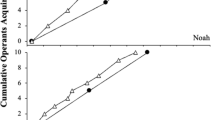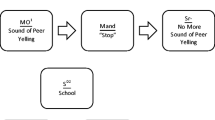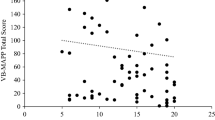Abstract
This study examined the functional independence of mand and tact operants in normally developing children and evaluated the role of SDs in demonstrating emergent responding. In Experiment 1, 4 children aged 4 to 5 years, were trained to mand or tact using left/right relations, then were tested for the emergence of the untaught tact/mand operant. None of the participants demonstrated an emergence of the untaught operant under standard antecedent conditions. However, all of the participants demonstrated an emergence of the untaught operant when the SDs were modified. Experiment 2 replicated the work in Experiment 1, using 8 participants. The conditions were reversed according to ABAB reversal design methodology and counterbalanced across participants. The findings demonstrated the important role of antecedent variables in emergent responding.
Similar content being viewed by others
References
EGAN, C. E., & BARNES-HOLMES, D. (2009). Emergence of tacts following mand training in young children with autism. Journal of Applied Behavior Analysis, 42, 691–696.
HALL, G., & SUNDBERG, M. L. (1987). Teaching mands by manipulating conditioned establishing operations. The Analysis of Verbal Behavior, 5, 41–53.
LAMARRRE, J., & HOLLAND, J. (1985). The functional independence of mands and tacts. Journal of the Experimental Analysis of Behavior, 43, 5–19.
MURPHY, C., & BARNES-HOLMES, D. (2009). Establishing derived manding for specific amounts with three children: An attempt at synthesizing Skinner’s Verbal Behavior with relational frame theory. The Psychological Record, 59, 75–91.
NUZZOLO-GOMEZ, R., & GREER, R. D. (2004). Emergence of untaught mands or tacts of novel adjective-object pairs as a function of instructional history. The Analysis of Verbal Behavior, 20, 63–76.
PARTINGTON, J.W., SUNDBERG, M.L., NEWHOUSE, L., & SPENGLER, S.M. (1994). Overcoming an autistic child’s failure to acquire a tact repertoire. Journal of Applied Behavior Analysis, 27, 733–734.
PETURSDOTTIR, A. I., CARR, J. E., & MICHAEL, J. (2005). Emergence of mands and tacts of novel objects among preschool children. The Analysis of Verbal Behavior, 21, 59–74.
SCHLINGER, H. (2008). The long good-bye: Why B. F. Skinner’s Verbal Behavior is alive and well on the 50th anniversary of its publication. The Psychological Record, 58, 329–337.
SIGAFOOS, J., REICHLE, J., DOSS, S., HALL, K., & PETTITT, L. (1990). “Spontaneous” transfer of stimulus control from tact to mand contingencies. Research in Developmental Disabilities, 11, 165–176.
SKINNER, B. F. (1957). Verbal behavior. New York: Appleton-Century-Crofts.
SUNDBERG, M. L., & MICHAEL, J. (2001). The value of Skinner’s analysis of verbal behavior for teaching children with autism. Behavior Modification, 25, 698–724.
SUNDBERG, M. L., SAN JUAN, B., DAWDY, M., & ARGUELLES, M. (1990). The acquisition of tacts, mands, and intraverbals by individuals with traumatic brain injury. The Analysis of Verbal Behavior, 8, 83–99.
TWYMAN, J. (1996). The functional independence of impure mands and tacts of abstract stimulus properties. The Analysis of Verbal Behavior, 13, 1–19.
WALLACE, M. D., IWATA, B. I., & HANLEY, G. P. (2006). Establishment of mands following tact training as a function of reinforcer strength. Journal of Applied Behavior Analysis, 39, 17–24.
Author information
Authors and Affiliations
Corresponding author
Additional information
These experiments were completed as part of the doctoral work submitted by Claire E. Egan to the Department of Psychology at NUI, Maynooth.
Rights and permissions
About this article
Cite this article
Egan, C.E., Barnes-Holmes, D. Examining Antecedent Control over Emergent Mands and Tacts in Young Children. Psychol Rec 61, 127–140 (2011). https://doi.org/10.1007/BF03395750
Published:
Issue Date:
DOI: https://doi.org/10.1007/BF03395750




